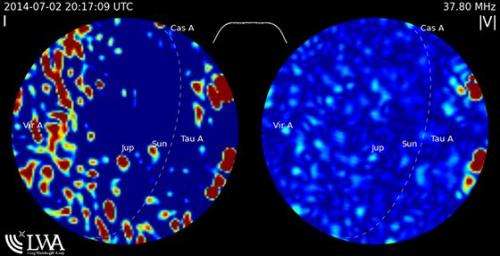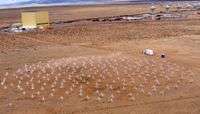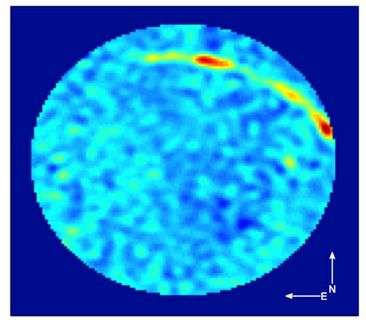Scientists discover radio emissions from fireballs

(Phys.org) —Streaking across the sky at more than 50 kilometers per second at atmospheric heights of more than a 90 kilometers high, researchers using the first station of University of New Mexico's Long Wavelength Array (LWA) saw something new that had never been seen before; something that could hold a treasure trove of new information in the world of physics.
The first station of the LWA, known as LWA1, is a unique telescope that consists of a collection of 256 dipoles combined into one massive array with a collective-area of a 100-meter dish. The LWA1, is a highly sensitive telescope that can create images of the entire sky. It allows researchers to keep eyes on the whole sky day and night, probing a relatively unexplored region of the electromagnetic spectrum.
Within six months of turning LWA1 on, UNM Department of Physics Professor Greg Taylor and his team got the all sky imaging up and running. Shortly thereafter, they started to search for transients, brief pulses of radio waves coming from the sky. Ken Obenberger, a UNM graduate student, and colleagues searched for transients in more than 11,000 hours of all-sky images from the LWA at frequencies between 25 and 75 MHz. In this data he identified 49 long (30 seconds or longer) transients.
"We would see a bright source appear in the sky and it would last for about a minute, and then it would go away," Obenberger said. "Most of them would come on at one point and then fade away. Sometimes they were a bit extended and a little bit resolved by the telescope, but oftentimes, they weren't," he added.
The research team didn't know what they were exactly. That situation went on for several months."When we found an event that streaked over 90 degrees across the sky (see Figure) we asked ourselves, 'could these be fireballs?'" Taylor asked. Fireballs are a class of meteor brighter than the planet Venus.

To investigate this possibility, the team utilized NASA's All Sky Fireball Network, an observatory consisting of 12 cameras located in the United States. While most of the cameras are in other states, two are located in southern New Mexico.
The researchers compared the times and locations of the 49 transients with data from the Fireball Network. They found that 10 of those transients corresponded both spatially and temporarily with fireballs. The optical always precedes the radio Obenberger says. "You have this bright optical fireball, then slowly the radio emission ramps up. The show is over in the optical stage fairly quickly after a few seconds, but then we have this radio emission lasting for about a minute."
These detections suggest that fireballs emit a low frequency pulse, something that no other telescope has ever seen, and this discovery has provided researchers with new insight into the physics of meteors.

There's still a lot more work to do explains Taylor. "We need to characterize the spectrum of the fireballs– that is how they look as a function of frequency and from that try and tease out the physics. It probably has something to do with particles that are energized by the fireball as it plows into the atmosphere. If you have charged particles in magnetic fields, you have radio emission at low frequencies. It'll be fun to learn about and it'll give us new information about meteors – maybe composition or something about the upper atmosphere. It's kind of a whole new ball game." Taylor explained.
Other similarly-equipped observatories will also try and detect them. "We have a sister observatory modeled after ours in Owens Valley, Calif. Now they're monitoring the sky, so they'll get a different view. They're going to catch transients as well and that'll provide additional useful information," Taylor says.
More information: "Detection of Radio Emission from Fireballs." K.S. Obenberger, G.B. Taylor, J.M. Hartman, J. Dowell, S.W. Ellingson, J.F. Helmboldt, P.A. Henning, M. Kavic, F.K. Schinzel, J.H. Simonetti, K. Stovall, T.L. Wilson. arXiv:1405.6772 [astro-ph.EP]. arxiv.org/abs/1405.6772
Provided by University of New Mexico


















